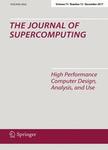版权所有:内蒙古大学图书馆 技术提供:维普资讯• 智图
内蒙古自治区呼和浩特市赛罕区大学西街235号 邮编: 010021

作者机构:Univ Adelaide Sch Comp Sci Adelaide SA 5005 Australia
出 版 物:《JOURNAL OF SUPERCOMPUTING》 (超高速计算杂志)
年 卷 期:2005年第34卷第2期
页 面:201-217页
核心收录:
学科分类:0808[工学-电气工程] 08[工学] 0812[工学-计算机科学与技术(可授工学、理学学位)]
主 题:parallel computing cluster computing performance modelling
摘 要:This paper gives an overview of two related tools that we have developed to provide more accurate measurement and modelling of the performance of message-passing communication and application programs on distributed memory parallel computers. MPIBench uses a very precise, globally synchronised clock to measure the performance of MPI communication routines. It can generate probability distributions of communication times, not just the average values produced by other MPI benchmarks. This allows useful insights to be made into the MPI communication performance of parallel computers, and in particular how performance is affected by network contention. The Performance Evaluating Virtual Parallel Machine (PEVPM) provides a simple, fast and accurate technique for modelling and predicting the performance of message-passing parallel programs. It uses a virtual parallel machine to simulate the execution of the parallel program. The effects of network contention can be accurately modelled by sampling from the probability distributions generated by MPIBench. These tools are particularly useful on clusters with commodity Ethernet networks, where relatively high latencies, network congestion and TCP problems can significantly affect communication performance, which is difficult to model accurately using other tools. Experiments with example parallel programs demonstrate that PEVPM gives accurate performance predictions on commodity clusters. We also show that modelling communication performance using average times rather than sampling from probability distributions can give misleading results, particularly for programs running on a large number of processors.